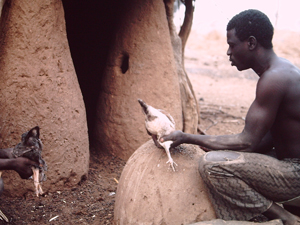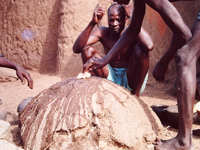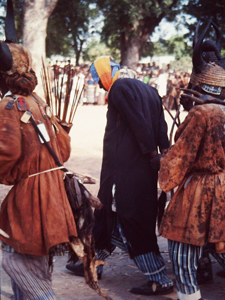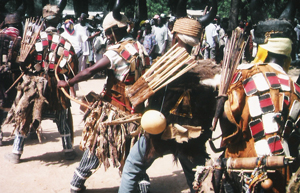 |
|
Feok-sacrifice to an ancestral shrine |
Mathias Apen
ORIGIN AND HISTORY: THE FEOK FESTIVAL OF THE PEOPLE OF BULUK
The Feok Festival is celebrated annually by the Bulsa. Before the year 1974, it did not exist as a district or national festive occasion but as a traditional harvest thanksgiving sacrifice practised in almost all traditional homes in Bulsa. The Feok Festival could therefore be appropriately described as a new creation by the Bulsa for the promotion of unity and accelerated socio-economic and political growth.
The Bulsa, who celebrate the Feok Festival today as one people, are no homogeneous people when it comes to the issue of their origins. They are indeed, a heterogeneous people with varying former ethnicities who migrated into the Bulsa enclave from the neighbouring tribes in the 16th century. The major ethnic groups that have settled in the Bulsa traditional area at various times in the past are the following: Kasena, Mamprusi, Nankana.
The minority tribes which did not have any significant influence on the development of the language and culture include the following: Kantosi, Moshi, Fulani, Talensi.
Fau, which has been corrupted gradually to Feo, Fiok, Feok (and more) is actually an age old idol worship practised by the Kasena or Kasem speaking tribe in their individual homes as their way of saying thank you to their individual gods (wena) and their ancestry for guarding/guiding them through preceding planting and harvest sessions. The Kasena brought this along with them when they migrated into the now Bulsa enclave or traditional area only for it to be adopted by almost all other tribes in the area except the Kantosi/Yarsi or Yarisa who are rigid faithful followers of Islam.
The other major tribes that migrated into the area with their individual traditional/cultural practices but only to abandon them soon for Feok are the Mamprusi who celebrated the Damba/Bogum/Fire festival and the Nankana who celebrated the Adaakoya, meaning ‘I last farmed’ thanksgiving which is similar to the Feok thanksgiving.
Feok, as it is popularly called, is still practised in all ancestor-worshipping homes in Bulsa.
The practice of Feok in traditional homes
 |
|
Feok-sacrifice to an ancestral shrine |
At the end of an annual planting and harvesting period, which is normally between April and November, living members of an individual household make sacrifices to their individual gods (wena) and the gods (wena) of the dead members of their families, for example mothers, fathers or (great) grandparents in appreciation of a successful farming, planting and harvesting season. Usually fowls are used in the sacrifice to male gods whilst guinea fowls are used in sacrifices to female gods. This, however, is a norm and not a strict prescription. However, in endowed families, goats or sheep are sacrificed to the gods of dead parents and great grandparents; and in well- endowed families, cattle are sometimes used in the sacrifice.
As a common practice, the birds and animals are slaughtered in the morning (and any day could be chosen for the occasion) and some of the their blood is spilled on the respective gods.
 |
|
Feok: Porridge is sacrificed to an ancestor |
Porridge (saab) of millet/sorghum is prepared in the evening to go with the cooked meat (of the sacrificed animals). Earlier in the day, the family notifies the extended family homes about the sacrifice and invites the children and young men to join them in celebrating the feast.
In the same vein, individual family members also invite their friends to their Feok festivity in the evening, when food, the meat and porridge of millet/sorghum (saab), would be served after the symbolic feeding of the gods. Some of the sacrificed food is sent to the immediate family compounds for the elderly people.
The pito sacrifice phase of the Feok
The sacrifice of food to the gods is followed a few weeks later by the sacrifice of pito (kpaamtuok). The pito which is brewed by the relevant family is used to symbolically wash off the blood of the slaughtered birds and animals spilled on the gods during the sacrifice of food and meat. The pito is drunk by invited extended family members, friends and any uninvited person who arrives at the scene.
The sacrifice of pito is the epilogue of the Feok for the year. It is essential to note here that while the traditional Feok is generally performed once a year, at the end of the harvest of the late millet in most homes, in some endowed homes, the ritual is performed twice a year; the first Feok sacrifice is made soon after the harvest of the early millet (naara) while the second sacrifice is made after the harvest of the late millet and sorghum.
The purpose of Feok
The objectives of Feok, as practised in the traditional homes include the following:
thanking the gods for the harvest and seeking their blessing and protection in the coming year
renewing family ties
renewing friendship
promoting peaceful co-existence
entertaining family members and friends
It is significant to note that Feok is celebrated in time of peace, happiness (i.e. when no deaths have occurred in the immediate family during the year) and plenty, and not in the name of war as it is being popularly touted these days.
It is very informative, too, to note that all the animals, birds and the grain used for the Feok thanksgiving sacrifice must, as a matter of norm, be the produce from individual/family farms. It is unusual to purchase or borrow items for this thanksgiving sacrifice.
In a unique case, the people of Gbedem (Gbedema), in addition to their individual home Feok sacrifice, come together to make sacrifices to the god (wen) of the greatest and first known forefather of their village, Agbiiroa, with a big funfair to epitomize their Feok activities for the year.
Regrettably, the traditional Feok, which is based primarily on affluence, is waning. For example, for the past three years no member of my family has performed his Feok responsibility. This has been attributed largely to their unsuccessful attempts to rear birds and goats and sheep during the period. In some other instances, families which have achieved some measure of success in livestock rearing would rather sell their produce than kill them for free consumption.
Feok, a festival of the whole Bulsa traditional area
The Feok which hitherto had been a domestic affair only, has since 1974 gained a district stature and recognition as an annual festival of the people of Bulsa. Indeed, the Bulsa Feok is the first Feok celebration to attain stature and recognition among the various ethnic groups in the Upper East Region which celebrate it. The new Feok Festival is different from the traditional thanksgiving Feok in its modus operandi as indicated below.
The creation of the Feok Festival was largely influenced by the successful annual meetings of the Bulsa Youth Association (BUYA) and can be said to be the brain child of the Association.
In 1969, the Bulsa Youth Association was formed and it had held several very successful annual meetings to consider critical issues of extreme value to Buluk. These issues included the following:
• promoting proper use of arable farm lands in Bulsa especially the Finbisa (Fumbisi) valley for the benefit of all Bulsa
• eradicating some “negative” traditional practices in the area
• promoting health and education
• advocating the general development of Buluk
The success of the Bulsa Youth Association in organizing its annual meetings was remarkable but its membership was deemed to be limited to some age group as its name implied and its activities naturally did not encompass all Bulsa.
With the realization that Buluk needed an activity that would bring the chiefs and people of the thirteen villages together for a common purpose, the Bulsa Youth Association started dreaming bringing into existence a big annual festival. This dream was crystallized in 1972. In 1973, the idea was presented to the then Paramount Chief Sandem-naab Azantilow Ayieta by Mr. Henry Akanko, the Chairman of the Bulsa Youth Association. Though Naab Ayieta favoured the idea, he wondered how such a big event could be financed. Consequently, no definite decision was taken on the proposal until early 1974 when the Paramount Chief approached the then District Chief Executive, head of the district administration and government representative in the district, Mr. Kwesi Marfo, for assistance.
According to Mr. Marfo, during one of his usual visits to Naab Ayieta Azantilow, the paramount Chief brought the idea of the festival up for discussion. When he was made aware of the importance of such a festival, he gratefully accepted the idea and decided to commit his time and some of the resources of the Local Council (assembly) to its organization.
BUYA was contacted and the preparation for the very firstFestival soon began in earnest.
The Bulsa Youth Association (BUYA) in its search for a name that would be acceptable to all Bulsa for the intended festival, settled on Feok since that was already a household name in Buluk.
The Traditional Feok sacrifice then subsequently metamorphosed into a festival with a huge touch of modernity and national in stature and character.
The main objects of the new Feok Festival outlined include the following:
To give thanks to God and the ancestors of the land [tanggbana] for a successful farming session
To bring Bulsa at home and abroad together to fraternize
To be a forum for the propagation of government policy
To serve as a launch pad for development projects
To attract tourists to the district
To showcase traditional Bulsa culture
To revive the history of Buluk
The first Feok Festival was eventually planned and organized by the Bulsa Youth Association, and the Bulsa Local Council / District Administration which provided the needed resources, in 1974.
The citizens mentioned below are hereby acknowledged for the important role they played in bringing the first Feok Festival to fruition:
Mr. Kwesi Marfo
Late Mr. Henry Akanko
Late Chief A. Afulang (Siniensi Chief)
Late Mr. Raphael Agriwan Adiita
Late Rev. James Agalic
From 1974 to 2003, the Bulsa District Administration/Assembly successfully organized the annual Feok Festival. On each occasion all chiefs and their respective entourage were invited to grace the occasion and to give it the needed traditional touch and flavour. To honour his active role in making the festival idea a reality, the Paramount chief, Sandem Naab Azantilow Ayieta became the chairman of the event.
In 2004, the District Assembly handed over the responsibility for organizing the Feok Festival to the Traditional Council. In the view of the Assembly the Festival is a traditional Affair.
Since then the Traditional Council, with an appreciable financial support from the District Administration/District Assembly, has been in charge of organizing the annual Feok Festival, a big event, that is always patronized by the chiefs and people of Bulsa at home and from abroad, top politicians and national and international tourists.
The FEOK FESTIVAL is planned to take place for a period of three days. All Bulsa citizens are expected to be available during the festival period and to attend the daily activities that take place in Sandema, the North Bulsa District capital.
During the period, various exciting competitive games take place. These games include the following:
 |
|
Feok Drama 2002: Babatu has been caught |
Archery (bow/arrow shooting)
Wrestling
Soccer (a recent innovation starting before the Feok Festival proper)
Singing, drumming and dancing (particularly war-dances)
Occasionally drama (e.g. “The capture of Babatu”, see photo).
On the final day, a grand durbar is chaired by the Paramount Chief is held in Sandem with all chiefs of Bulsa in attendance.
The Durbar is also usually attended by the following:
• The District Chief Executive and his supporting staff.
• Invited Dignitaries including the President /Head of State and Regional Ministers
• Tourists (national and international)
• Bulsa people at home and from abroad.
The performance of the war dance (leelik) which has become an integral part of the Feok Festival and signifies a call to war, is more importantly a ritual dance in the traditional context performed to honour a very high profile landlord during his final funeral rites. Such a landlord is usually one who inherited great family gods and was responsible for offering sacrifices to these gods during his lifetime and tenure as landlord (Yeri nyonoa waai ale kaab bogluk kpienta).
 |
|
Feok 2002: War Dance |
The significance of the war-dance at the Feok Festival
The war dance (leelik) was adopted for the Feok Festival for three cardinal reasons:
• To entertain the people who attend the festival
• To showcase the rich culture of the Bulsa people
• To revive the historic past of the brave Bulsa warriors who fought and defeated the notorious Zambarama slave raiders on three occasions (twice in battles at Kanjak /Kanjaga and once at Sandem).
Literature
Schott, Rüdiger; 1977: Sources for a History of the Bulsa in Northern Ghana. Paideuma 23, pp. 141-168.
Ayaric, Ghanatta: 2014 Three Educated Bulsa Generations (Chapter: The Builsa Youth Association). Buluk 9.